Lucky you live Hawaii
Hawaii hotel workers earn among the highest wages of any hotel worker in the nation. According to the US Bureau of Labor Statistics, the average annual pay of Hawaii hotel workers was $31,045 in 2003. Maui County hotel workers did even better with an average pay of $32,526
The only hotel workers who earned more were in the state of Maryland and the District of Columbia, where they averaged $33,018 and $32,746 respectively.
New York City hotel workers are probably the highest paid hotel workers in the country. In 2003, their average pay was an impressive $42,552 a year, but hotel workers outside of the city earn far less. The statewide average for New York is $30,355, much lower than Hawaii’s statewide average of $31,045.
Hawaii even did better than Las Vegas, where workers in the casino hotels averaged $30,524 in annual wages.
Thanks to unionization
The high wages of hotel workers in Hawaii, New York, Las Vegas, and other areas is the direct result of unionization. The workers in these areas are organized into unions and have the power to negotiate higher wages and benefits. Through the years, these unionized workers have made tremendous gains in improving their conditions as workers.
On the other hand, hotel work in most of the United States remains low paid and deadended. In 25 states, the average pay is less than $8.00 an hour. In South Dakota and Mississippi, hotel workers earn just a few cents more than the federal minimum wage of $5.15 an hour. These are areas of low unionization, where so called “right-to-work” laws have been passed to weaken unions.
What’s Average?
The US Bureau of Labor Statistics calculates the average pay by taking the total wages paid and dividing that by the total number of workers. “Total wages” is only what is reported to the state for unemployment purposes and will not include unreported tips and gratuities. The total number of workers does not adjust for the fact that many hotel workers are part-time. The actual annual pay for full-time workers would be much higher than the calculated average.
This information is from the US Bureau of Labor Statistics “Census of Employment and Wages” — http://www.bls.gov/cew/ cewover.htm. Their website also contains information on the average earnings of workers in all industries.
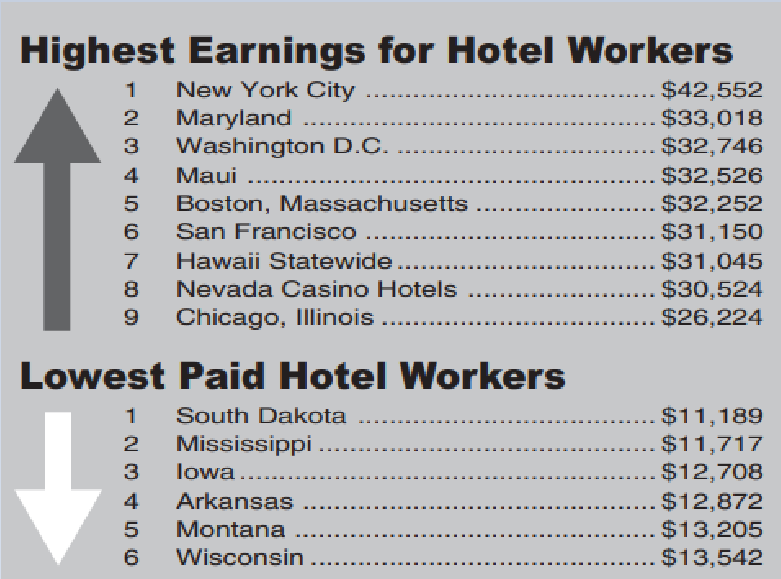
Hotel workers win with ILWU
There are about 36,000 hotel workers in Hawaii. Take out management and other non-bargaining employees and there may be about 28,000 “production” workers in the hotel industry. The ILWU Local 142 has about 11,000 hotel members and HERE Local 5 (Hotel Employees and Restaurant Employees Union) has about 9,000 hotel members.
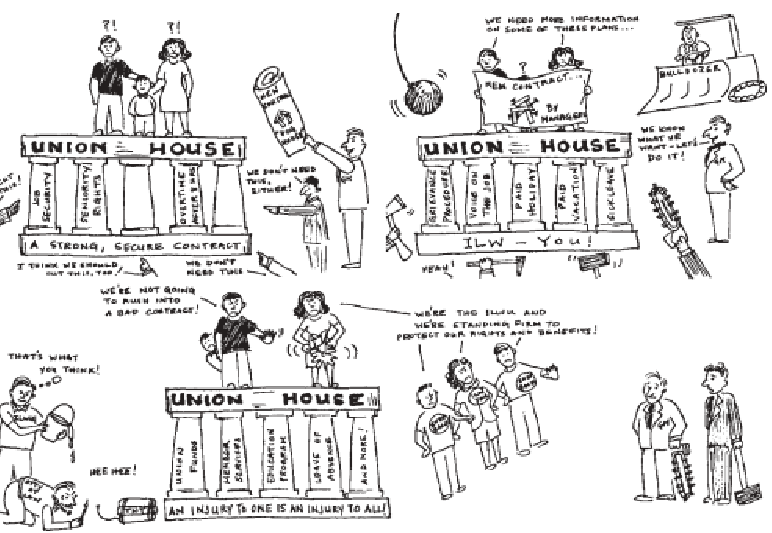
Cartoon from the 1995-96 hotel negotiations, during which ILWU hotel members maintained solidarity and fought hard to get fair contracts.
This adds up to 20,000 union members which means about 70% of Hawaii’s hotel industry is unionized. This high level of unionization explains why Hawaii’s hotel workers have some of the best wages and benefits of any hotel worker in the nation.
Almost all of the ILWU’s 11,000 hotel members are on the neighbor islands of Hawaii, Maui, Lanai, Molokai, and Kauai. Only 140 of our hotel members are on Oahu. HERE’s membership is mainly in Waikiki on Oahu, where they have 16 organized hotels
ILWU and Hotels
How is it that the ILWU has more hotel workers than HERE and why are ILWU members mostly on the neighbor islands while HERE is concentrated in Waikiki?
Go back 45 years to 1960. Hawaii’s tourism industry was just beginning to expand rapidly with the introduction of jet aircraft like the Boeing 707 which cut travel time in half to 5 hours. Propeller aircraft like the Boeing 377 Stratocruiser took 8 - 10 hours to cover the 2,400 miles from California to Hawaii.
Waikiki was the primary tourist destination where 80 percent of the visitors stayed. Most of the big hotel chains like the Sheraton and Hilton had hotels in Waikiki, which were organized by the AFL-CIO Hotel Employees and Restaurant Employees Union.
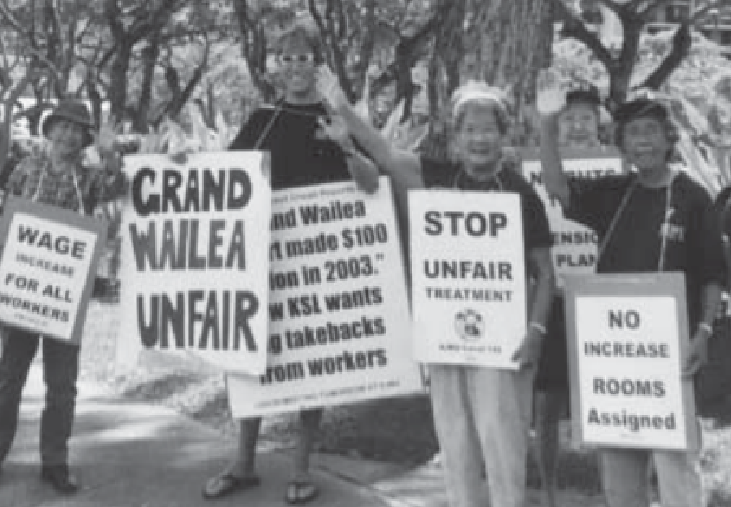
Maui ILWU members at Grand Wailea Resort Hotel & Spa fought for and won a fair contract.
In 1960 there were only a handful of hotels on the neighbor islands with a total of 1,100 rooms. The wives and daughters of many of our sugar and pineapple members worked in these hotels and they wanted to unionize to improve their conditions. In response, the ILWU began a major campaign to organize neighbor island hotels, starting with five hotels owned by InterIsland Resorts. Those hotels were the Naniloa Surf, Kona Inn, Kaiaka Lodge, Kauai Inn, and Kauai Surf.
ILWU wins first election
Under US labor law, workers can unionize if a majority of them vote in favor of the union. The election is supervised by the National Labor Relations Board (NLRB) and both the union and company have a period of time to campaign for the workers’ vote. The company has the advantage because they have daily access to the workers. To offset this advantage, the NLRB requires the company to provide the union with a list of workers and their addresses. This allows the union to visit these workers at home to explain the benefits and advantages of unionizing .
ILWU members from other industries helped in the organizing and visited and talked with hundreds of InterIsland Resorts workers on Hawaii and Kauai. Their efforts and hard work paid off as the overwhelming majority of InterIsland Resorts workers voted in favor of the ILWU in 1960 and again in 1962.
Maui organizes
After the InterIsland Resorts victory, the ILWU turned its organizing efforts to Maui. The union continued the successful strategy of using members from other industries like sugar and pineapple to help with the organizing by talking to hotel workers. In 1964, Royal Lahaina Resort workers voted to join the union, which was followed by an election win at the Kaanapali Beach Hotel in 1965.
In the next few years, the ILWU won elections at the Mauna Kea Beach Hotel, the Maui Lu Resort, the Sheraton Volcano House, and the Hotel King Kamehameha.
In most of these elections, the other hotel union (HERE) would intervene and get on the ballot so workers actually had the choice between two unions. But the ILWU had the advantage of a large, existing membership on the neighbor islands, a reputation as a clean and democratic union, and the involvement of rank-andfile members in organizing.
The ILWU continued to win elections in the 1970s and 1980s, adding another 20 hotels to the ILWU family. By the end of the 1980s, the ILWU had more hotel members than HERE and ILWU wages and benefits were equal to or better than Waikiki.
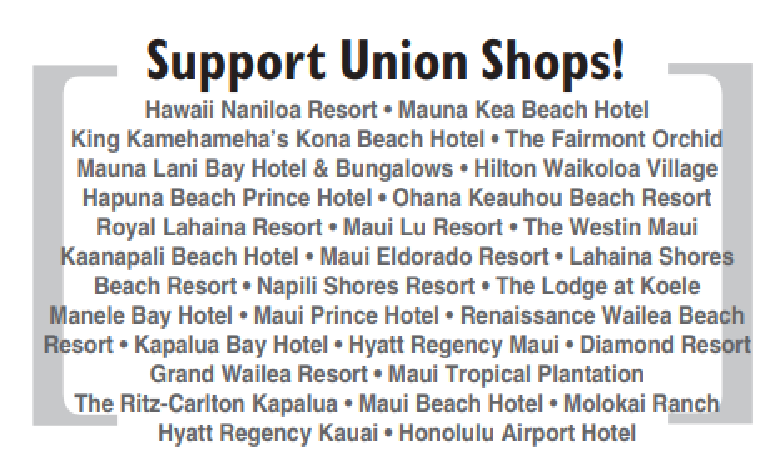
Getting good contracts
Winning the election is just the beginning—it only requires the employer to negotiate with the union. In order to improve wages and working conditions and get a good contract, the newly organized workers must get actively involved and continue to support their union.
When the ILWU negotiated its first hotel contracts in 1962, the union used principles of industrial unionism which were significantly different from the HERE contracts in Waikiki. HERE was formerly a bartenders union organized along craft lines and their contracts tended to favor the skilled jobs.
The ILWU organized all workers in the hotel and negotiated contracts that benefit all workers with no divisions by skill or craft. ILWU hotel contracts contain strong language to preserve seniority and job status. A lot of contract language is designed to take care of workers as they build seniority — more sick leave, more vacation, long term disability insurance, and preservation of seniority in case of long illness or disability.
Equality and solidarity
By organizing industrially, the ILWU had to build solidarity among workers who do very different jobs, immigrants and locals, men and women, skilled and less skilled, and so on.
One of the major divisions in a hotel is between the “front of the house” and “back of the house.” “Front of the house” are those jobs that have regular contact with hotel guests—front desk, lobby, recreation, and restaurants. “Back of the house” are those jobs that keep the hotel running but have much less contact with hotel guests— housekeeping, laundry, grounds, maintenance, and kitchen.
Another major divisions is tipping and non-tipping workers. Tipped workers are waithelp, banquet workers, and bell attendants who earn most of their income from tips. Non-tipped workers are everyone else.
Recent immigrants tend to concentrate in the back of the house. People who grew up speaking English tend to be in tipping categories in the front of the house. The majority of housekeepers are women, while maintenance is mostly men.
The ILWU was able to build solidarity among all these groups by using ILWU principles of equality and democracy. The union made sure negotiating committees had members from each of these groups or could at least fairly represent the interests of these groups. The negotiating process also had to be democratic—members had to be involved in putting together the initial demands, members had to be informed and mobilized during negotiations, and members had to approve any final agreement.
Union gains
The high level of unionization has enabled Hawaii hotel workers to make tremendous gains in wages, benefits, and working conditions. Before the union, hotel work was temporary until you could find a better job. Today, unionized hotel workers can make a good living and many make it their lifelong career.
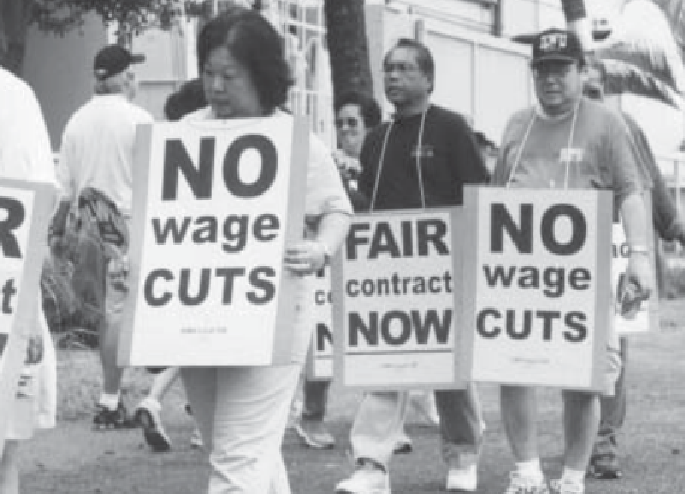
ILWU, Hawaii Government Employees Association (HGEA) and other union members joined an informational picket in support of New Otani Kaimana Beach Hotel workers, who are trying to get a first contract. Participants included Local President Fred Galdones (second from right) and Local Secretary-Treasurer Guy Fujimura (right).
